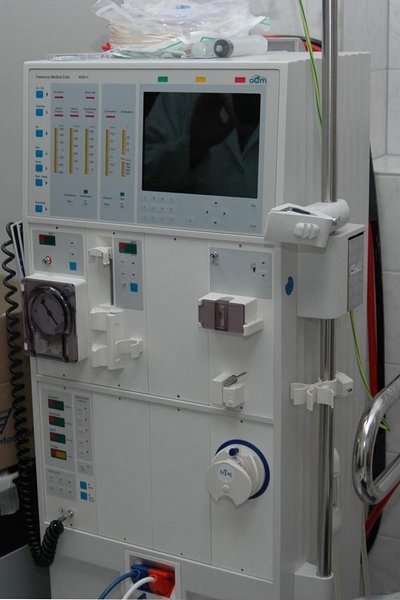August 5, 2010
Regional differences found in treating end-stage kidney disease in elderly Americans
Treatment for end-stage kidney disease varies for older Americans, depending on the region where they live, according to a study published in the July 14 Journal of the American Medical Association (JAMA).
Regions where health-care spending and utilization among Medicare beneficiaries during the last six months of life were greatest (high end-of-life intensity-of-care regions) were also places where health-care professionals were more aggressive in starting dialysis in elderly patients, the JAMA study found. Dialysis involves periodically circulating a patient’s blood through an artificial kidney machine.
“The regional differences were most pronounced for very elderly patients age 85 and over, a group for whom the benefits of dialysis are least certain,” noted lead author Dr. Ann M. O’Hare, associate professor of medicine in the Division of Nephrology.
Also on the research team were Dr. Manjula Kurella Tamura of Stanford University and the Palo Alto Health Care System, Dr. Rudolph A. Rodriguez and Dr. Eric B. Larson of the UW Department of Medicine, along with New York epidemiologist Dr. Susan B. Hailpern. Larson is also with the Group Health Research Institute in Seattle, and O’Hare is with the Health Services Research and Development Center of Excellence at the Veterans Affairs Puget Sound Health Care System.
The study reported large regional variations in how often dialysis is discontinued before death. Compared to regions with the lowest end-of-life intensity of care, the rates of stopping dialysis treatments before the patient died were 50 percent lower in high intensity regions. Elderly dialysis patients dying in high intensity regions were less likely to have received hospice care and were more likely to die in a hospital.
“The regional differences in rates of discontinuing dialysis were more pronounced than differences in discontinuation rates between black and white patients, and younger and older patients,” O’Hare observed.
Generally, chronic dialysis treatment is ongoing unless a deliberate, explicit decision is made to discontinue this therapy. The study results demonstrating large regional differences in rates of continuation support the possibility that physician practice styles vary by region, and that there may be a greater willingness to address the goals of end-of-life care lower intensity regions. Other factors may play a role. O’Hare said there is considerable debate about the underlying reasons for, and significance of, regional differences in intensity of care.
The study also found that, although high intensity regions had more nephrologists — physicians specializing in kidney disease — older adults were less likely to have been under the care of nephrologists before starting dialysis in these regions. Sometimes a late referral is unavoidable if a patient rapidly and unexpectedly enters end-state kidney failure, O’Hare said, but ideally, patients with advanced kidney disease would have had an opportunity to receive specialized care from nephrologists well ahead of the potential need for dialysis.
“A more timely referral would not only allow for interventions to slow or prevent the progression of kidney disease, but also would enable patients to learn about their disease, their probable prognosis, their treatment options, and what to expect,” O’Hare said. “Pre-dialysis planning takes time, if done well. Treatment decisions often evolve as patients learn more about their options and prognosis, come to term with these realities, encounters a change in health status, or has an ongoing dialog with their nephrologist. If patients don’t have a chance to engage in planning before the need for dialysis arises, decisions are often rushed or based on unrealistic expectations.
O’Hare said that she hopes that the study findings will simulate discussion and research that ultimately will help assure that older adults with advanced kidney disease receive care that is in keeping with their preferences and values. She mentioned that whether and when to start and stop receiving dialysis treatments can be difficult decisions for older patients with advanced kidney disease. At the same time these decisions have great potential to influence how patients and families will experience their remaining time together.
“Our data seem to suggest that at present these important decisions are heavily influenced by where patients live,” O’Hare said. Strong evidence for what approach to take is lacking. There is substantial uncertainty about the effect of treatment decisions on outcomes that matter to patients, particularly very elderly patients and patients who have other significant medical problems.
O’Hare suggested that kidney specialists and other health professionals caring for elderly patients receive appropriate training in end-of life care and support from their colleagues in geriatric and palliative care.
“As health professionals, she said, “we should be more deliberate in our approach to helping patients and their families grapple with decisions about dialysis initiation and discontinuation.”
Beeson Career Development Awards from the American Federation for Aging Research (AFAR) to O’Hare and Kurella supported the study.
The study used data from the U.S. Renal Data System, a national registry for end-stage kidney disease. High intensity and low intensity hospital referral regions were determined through an expenditure index from the Dartmouth Atlas of Health Care.

